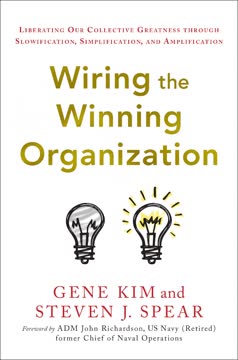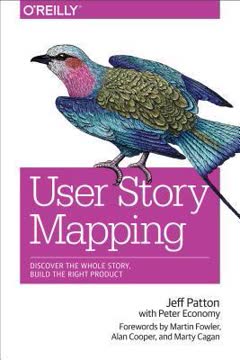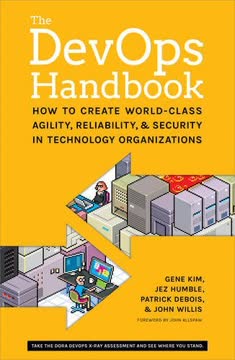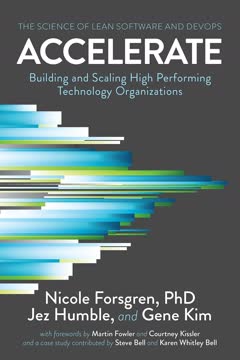Key Takeaways
1. The Age of Software: Navigating the Fifth Technological Revolution
At the current rate of disruption and decline, half of S&P 500 companies will be replaced in the next ten years.
Digital disruption is accelerating. We are currently in the fifth major technological revolution, the Age of Software, which began in 1971 with the introduction of the microprocessor. This age is characterized by the digitization of the economy, with software becoming the core means of production. The revolution follows a pattern of Installation Period, Turning Point, and Deployment Period. We are currently in the Turning Point, where businesses must master software delivery to survive and thrive.
Key aspects of the Age of Software:
- Software is eating the world, disrupting traditional industries
- Tech giants and digital natives have mastered software delivery
- Traditional businesses struggle to adapt to the new paradigm
- Mastering software delivery is crucial for survival and success
2. From Project to Product: A Paradigm Shift in Software Delivery
Project-oriented management gets in the way of the autonomy, mastery, and purpose identified by Pink as key to job satisfaction, whereas product-oriented stability of work and teams promotes them.
A fundamental shift is needed in how organizations manage software delivery. The traditional project-oriented approach, rooted in past technological revolutions, is inadequate for the Age of Software. Instead, businesses must transition to a product-oriented mindset, focusing on continuous value delivery and long-term product life cycles.
Key differences between project and product orientation:
- Time frames: Projects have defined end dates; products have ongoing life cycles
- Budgeting: Projects have fixed budgets; products have continuous funding based on value
- Success metrics: Projects focus on time and budget; products focus on business outcomes
- Risk management: Projects front-load risk; products spread risk across iterations
- Team structure: Projects reassign people; products maintain stable, cross-functional teams
3. The Flow Framework: Connecting Business and Technology
The Flow Framework provides a simple path to answering these questions. There are key staff within your organization who already know the answers, but their efforts and vision need to be connected to an organizational strategy and approach.
A new management framework is needed to bridge the gap between business and technology in the Age of Software. The Flow Framework provides this connection, enabling organizations to measure and optimize the flow of business value through software delivery. It focuses on end-to-end visibility and aligns technology investments with business outcomes.
Core components of the Flow Framework:
- Four flow items: Features, Defects, Risks, and Debts
- Flow metrics: Distribution, Velocity, Time, Load, and Efficiency
- Value Stream Networks: Connecting tools, artifacts, and products
- Business results: Value, Cost, Quality, and Happiness
4. Value Stream Metrics: Measuring Software Delivery Performance
Value, cost, quality, and happiness are the four buckets of business results that need to be tracked as part of the Flow Framework in order to correlate software investment with business performance, and to provide a common set of results-oriented metrics to connect the business with IT.
Measuring what matters is crucial for effective software delivery management. The Flow Framework introduces Value Stream Metrics, which provide a comprehensive view of software delivery performance and its impact on business outcomes. These metrics move beyond proxy measures and activity-based metrics to focus on actual value delivery.
Key Value Stream Metrics:
- Flow Distribution: Proportion of each flow item type
- Flow Velocity: Number of flow items completed over time
- Flow Time: Duration from start to completion of flow items
- Flow Load: Number of active flow items (work in progress)
- Flow Efficiency: Ratio of active time to total time for flow items
5. Flow Distribution: Balancing Features, Defects, Risks, and Debts
The zero-sum game of flow-distribution trade-offs forces the business to make the kinds of trade-offs that the development team lead has to make constantly as unplanned work enters the value stream.
Balancing priorities is essential for effective software delivery. Flow distribution represents the proportion of work allocated to each of the four flow items: Features, Defects, Risks, and Debts. This metric provides a mechanism for aligning delivery activities with business strategy and enables informed decision-making about resource allocation.
Considerations for flow distribution:
- Features: New business value visible to customers
- Defects: Quality issues affecting customer experience
- Risks: Security, compliance, and governance concerns
- Debts: Impediments to future delivery (e.g., technical debt)
6. Value Stream Networks: The New Infrastructure for Innovation
Software value streams are not linear manufacturing processes but complex collaboration networks that need to be aligned to products.
A new infrastructure is needed to support software delivery in the Age of Software. Value Stream Networks provide this infrastructure, connecting the various tools, artifacts, and activities involved in software delivery. This network approach enables organizations to achieve the flow and feedback necessary for effective software innovation.
Components of Value Stream Networks:
- Tool Network: Connecting specialized software delivery tools
- Artifact Network: Linking work items across tools and processes
- Value Stream Network: Aligning activities to product value streams
- Integration Model: Mapping artifacts across tools
- Activity Model: Defining workflow states and activities
- Product Model: Connecting value streams to business results
7. Surviving the Turning Point: Thriving in the Digital Future
We have both a corporate and a social responsibility to turn this tide. The tech giants have mastered the new means of production to the point where the consumer and business services they provide are so valuable that attempting to slow progress will be counterproductive.
Adapting to thrive in the Age of Software is crucial for organizations and society. As we navigate the Turning Point of this technological revolution, businesses must transform their approach to software delivery to remain competitive. This transformation requires a shift in mindset, management practices, and infrastructure.
Steps to thrive in the digital future:
- Embrace product-oriented management
- Implement the Flow Framework
- Create and manage Value Stream Networks
- Focus on delivering business value through software
- Continuously adapt and learn from market feedback
- Invest in talent and foster a culture of innovation
Last updated:
FAQ
What's Project to Product about?
- Digital Transformation Focus: Project to Product by Mik Kersten explores how organizations can transition from a project-oriented approach to a product-oriented mindset in the Age of Software. It emphasizes adapting to digital disruption.
- Flow Framework Introduction: The book introduces the Flow Framework, a managerial tool that connects technology investments to business outcomes, aiming to improve efficiency and value delivery.
- Real-World Examples: Kersten uses case studies from companies like BMW and Nokia to illustrate the challenges and successes of digital transformation, highlighting the pitfalls of traditional project management.
Why should I read Project to Product?
- Relevance to Modern Businesses: Essential for those involved in software delivery, product management, or digital transformation, as it addresses the urgent need to adapt to the Age of Software.
- Practical Framework: Offers actionable insights and a practical framework (the Flow Framework) to improve software delivery and align it with business goals.
- Expert Insights: Mik Kersten provides a unique perspective on the intersection of technology and business, helping organizations avoid common pitfalls in their transformation journeys.
What are the key takeaways of Project to Product?
- Shift to Product Management: Organizations must transition from project-based thinking to a product-oriented mindset to remain competitive and deliver continuous value.
- Importance of Value Streams: Understanding and managing value streams is crucial for optimizing software delivery and ensuring customer satisfaction.
- Integration of Business and IT: Better integration between business strategies and IT operations is necessary, with the Flow Framework providing a common language for alignment.
What is the Flow Framework in Project to Product?
- New Management Approach: The Flow Framework helps organizations visualize and manage their software delivery processes, connecting technology investments to business outcomes.
- Four Flow Items: It identifies four key flow items—features, defects, risks, and debts—that represent different types of work in a software value stream.
- End-to-End Visibility: Provides end-to-end visibility of business value flow, allowing organizations to identify bottlenecks and optimize processes.
How does Project to Product address digital disruption?
- Understanding Digital Disruption: Explains that digital disruption is a predictable outcome for companies that fail to adapt to new production means, especially in the Age of Software.
- Case Studies: Uses real-world examples, such as Nokia's failure to adapt, to illustrate the consequences of ignoring digital disruption.
- Framework for Adaptation: The Flow Framework offers a structured approach for aligning software delivery processes with business goals to maintain competitiveness.
How does the Flow Framework help in measuring success?
- Flow Metrics: Provides specific metrics, such as flow time and flow velocity, to measure performance in delivering value and identify areas for improvement.
- Business Correlation: Correlates flow metrics with business results, helping organizations understand the impact of software delivery on overall performance.
- Continuous Improvement: Encourages a culture of continuous improvement by providing insights into bottlenecks and inefficiencies.
What are the four flow items defined in Project to Product?
- Features: Represent new business value delivered to customers, prioritized based on customer needs.
- Defects: Issues affecting product quality that must be addressed to maintain customer satisfaction.
- Risks: Encompass security, compliance, and governance issues that need proactive management.
- Debts: Refer to technical debt that can hinder future development efforts, requiring prioritization for reduction.
What are the Management Zones mentioned in Project to Product?
- Three Management Zones: The Performance Zone, Transformation Zone, and Incubation Zone represent different stages of product development.
- Performance Zone: Focuses on delivering high-quality, stable products that generate revenue, prioritizing efficiency and reliability.
- Transformation and Incubation Zones: The Transformation Zone is for innovation and adaptation, while the Incubation Zone explores new ideas and technologies.
How does Project to Product suggest measuring success?
- Value Stream Metrics: Emphasizes measuring success through value stream metrics that track the flow of business value in software delivery.
- Business Outcomes: Success should be measured in terms of business outcomes like revenue, customer satisfaction, and employee engagement.
- Continuous Improvement: Encourages a mindset of continuous improvement, using metrics to identify areas for enhancement.
How does Project to Product address the concept of technical debt?
- Definition of Technical Debt: Described as the cost of future rework due to shortcuts taken in the present, impacting software delivery.
- Impact on Flow: Excessive technical debt can slow down flow velocity and increase flow time, affecting value delivery.
- Strategies for Management: Provides strategies for addressing technical debt, such as allocating time for debt reduction and prioritizing it alongside feature development.
What role do case studies play in Project to Product?
- Real-World Examples: Uses case studies from companies like BMW and Nokia to illustrate concepts and frameworks, providing context for readers.
- Lessons Learned: Highlights key lessons from successes and failures in digital transformation, helping readers avoid common pitfalls.
- Illustrating the Flow Framework: Demonstrates how the Flow Framework can be applied in real-world scenarios, showcasing its effectiveness.
What are the best quotes from Project to Product and what do they mean?
- "Organizing software development as a group of loosely connected projects will never lead to good products.": Emphasizes the importance of a product-oriented approach over a project-based mindset.
- "The Flow Framework is a new way of seeing and measuring delivery and aligning all of your IT investments according to value streams.": Highlights the framework's role in transforming software delivery management.
- "If you want to get rid of obsolete practices and succeed with the new digital, read this book.": Encourages organizations to embrace new methodologies to remain competitive.
Review Summary
Project to Product receives mixed reviews, with an average rating of 3.93/5. Many praise its insights on transitioning from project to product-based development and the Flow Framework for managing value streams. Readers appreciate the book's emphasis on business value and alignment with digital transformation. However, some criticize it for lacking practical implementation details and being overly focused on large enterprises. The BMW manufacturing analogy is contentious, with some finding it helpful and others seeing it as misaligned with software development realities.
Similar Books










Download PDF
Download EPUB
.epub digital book format is ideal for reading ebooks on phones, tablets, and e-readers.




